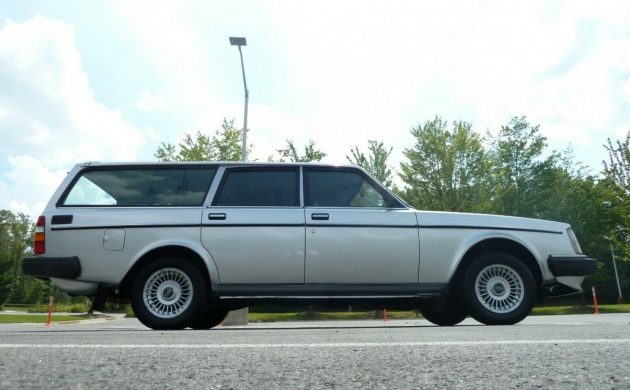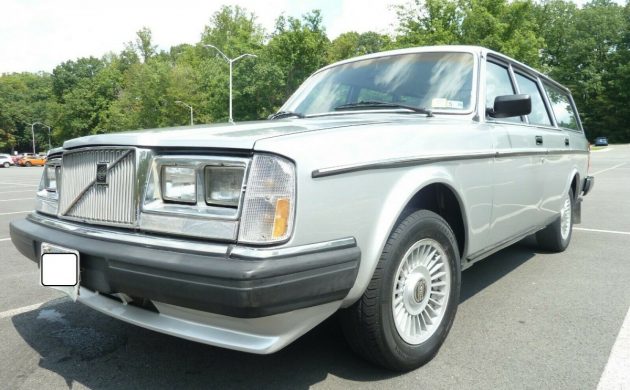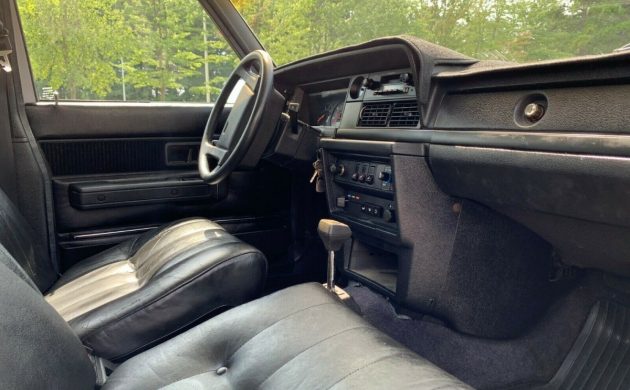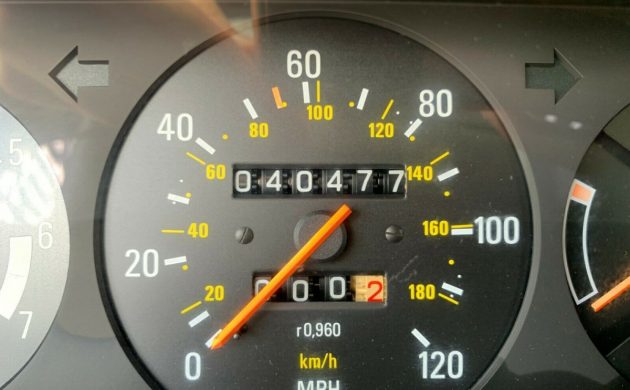Volvo’s 200 Series is a simple vehicle, yet it is very beloved among enthusiasts. Although the company sold 2.8 million units worldwide, finding a pristine and low-mile example is somewhat of a challenge. However, this 1985 Volvo 240 GL Wagon that’s available here on eBay fits the aforementioned criteria quite well.
This wagon is available in Fairfax, Virginia with a clean title. In the advertisement, the seller recounts how they purchased the vehicle from a 93-year-old grandmother, who purchased the vehicle new in 1985 and imported it from Europe. The vehicle was sparingly used, and the sale includes receipts dating back to 1985. Once the original owner was no longer able to operate the vehicle, she parked it in the driveway and eventually agreed to sell it.
After tackling mechanical issues, the seller took the wagon to a classic-specific body shop, where the vehicle received a respray in the original Silver color. The seller also sourced original trim, lights, seats and more from all around the world.
The interior is in impressive shape – though it has some wear, it looks well preserved. There is a mat covering the dashboard, which usually means the dashboard material has cracks, but hopefully this isn’t the case with this clean 240.
Under the hood, you’ll find a 2.3-liter 4-cylinder engine, which only has 40,477 original miles. The engine pairs to an automatic transmission to drive the rear wheels, and the seller spent months and thousands of dollars procuring original parts to ensure it runs excellently.
At the time of publication, bidding for this wagon is at $8,049. Would you add this freshly reconditioned Volvo to your collection?








This car was recently RNM on ‘the other site’, there is a good comment thread.
https://bringatrailer.com/listing/1985-volvo-245-2/
+1 on Chebby’s comment. Check out that thread. Buyer beware.
As a 240 owner, I know the B-23 redblock engine will outlive us all.
Slow stodgy old Swedish car that will last almost forever if even moderately maintained. When I was a Volvo service manager I showed a picture that I had at the time to a customer who had just sent a letter to Volvo about their experiace with their car. It basically said that they had purchased their 240 Wagon new when their daughter was born because of the safety aspects/reputation of the car. The car had served them well and when that same daughter was driving age. They handed the car down to her. After a couple of years of driving the car she was in a terrible accident ( not her fault) where the car was shoved over a cliff. The daughter received only minor cuts and bruises but the car was a total loss. Little did they ever think that the car they purchased to protect their baby. Would in fact protect their baby 20 years later.
The picture that I showed them was 4 Volvo 240 wagons stacked on top of each other with no pillar deflection on the bottom car. VERY Strong car! And the 7 series cars (740, 760, etc.) were even stronger! Volvos of old were unbelievable cars, but I would not give you a nickel for anything produced after and including the era of the 850. (Good engines for the most part on those cars, but that is all)
JMHEO!
I agree with Wayne. The 740/760 were the best Volvo cars from that era. Those 2.3 liter engines were bullet proof. I had a 740 GLE that was well over 27 years old and had over 300,000 on the odometer when given to a needy family. The only issue with that car was the under hood wiring that would cook and become brittle with time.
71Boss351, yes the under the hood wiring was really the only common issue with the 7 series cars. There was a problem with the 7 series turbo cars if the transmission had been overheated. The rubber check balls in the valve body would deteriorate/shrink? to undersized and pass through the divider plate in the valve body. This caused a major “shift kit” hammer shift into second gear that you knew would tear out the differential. ( but it didn’t) The fix was to remove the transmission and replace the rubber balls with steel ones. I was able to pull off the install with the transmission still in place. ( you never saw anyone move so slow and gently so that the balls would stay in place on that flat divider plate) Problem fixed. The 240s were hard on heater cores and the 260 engines were just junk. (Blue book was always at half value of the 4 cylinder cars, which is why I installed a Ford 5.0 in my 260 wagon when the six died prematurely) Now that was a very fun car!
Great car and indestructible engine and transmission. Just one thing…..It’s a feat to try to merge onto a highway, especially if you have passengers in the car. This car has absolutely no power! Passing another car is also taking your life in your hands!
“…I installed a Ford 5.0 in my 260 wagon…”
“flyin brick”
Yes I had this car, an ’82 240 GL waggy in silver – the leather’n nicer wheels, OD auto(over the DL). After 250K they could not stop the rear main seal leak. Got 12 yrs out of that used car. 1st’n only wolwo so got another as I simultaneously picked up a mortgage. Short dirt drive but v e r y steep so got frnt wheel drive (850). Wrong, a used 700 series would have been right. The new 5 cyl was no match for the 240. Interference head (& it went, a 3K$ fix)…
crlsful, Most Volvo engine oil leaks are caused by a plugged flame trap. Which causes extreme crankcase pressure. The flame trap is basically the crankcase ventilation system that keeps oil in the pan and possible backfire (as in flames!) out of engine oil/fuel vapors. It is a little plastic devise that can be usually cleaned/unplugged and is somewhat accessible. I even talked my very non-mechanical sister through changing hers after her local mechanic told her that the engine needed to be replaced because of all the crankcase pressure causing all seals and gaskets to leak. (her trap broke when removing it) Once replaced the car had no more leaks and she drove the many more years after that. She would still be driving it but was rear ended quite badly (at about 50 MPH with no braking attempted) and the car was totaled. (she was very sore for a few days) A new flame trap is less than $20.
Great cars!
Volvo crackhead here reporting in…never listen to the naysayers, a Volvo 240 will roll down the highway just fine at 85mph. Fuel economy ? Who cares ! Comfort ? Notice the tufted leather chairs ? Uh huh. Set of spark plugs from the parts room, tank of high test & THE ONLY CAR that would give you NO PROBLEM driving across America.
If the quality of a 240 is that good , then why did the seller had to spend so much money on a 40.000 mls car?
K F van der Bijl, Miles has rarely had anything to do with age. Would you take off on a vacation to drive 3,000 miles down the interstate at 70 mph on 12 year old tires that only have 10,000 miles on them? Or hope that the 10 year old coolant in the radiator will not corrode the system to the point of system failure? Hydraulic brake systems work fine sometimes for 20 years with no issues. But, sitting for many years, rot and deterioration happens with lack of use. If you are lucky enough to find a good quality car with very low miles (which means lack of use) It is money well spent to have things checked out and serviced before seeing “regular” use. Certain things wear and certain things deteriorate. Working in a car dealership you can see these things happen to a car that just sits on the lot with no sale and virtually no test drives. It is called “lot rot”. Even when the vehicle was checked over and given the ok (and/or repaired) for problems and safety. After a few months leaks start, parts start falling off (trim) lack of driving and full warm up trips cause condensation, batteries operating at less than ideal voltages, brake friction materials start “gluing” them selves to drums and rotors, parking brake cables start rusting, tires deteriorate, etc.
The worst case I saw when I was a BMW service manager. Was we had a very pretty E30 (325) convert. traded in. It required a few items and we had the service records on the car. The timing belt had been replaced about 20,000 miles previously and had about 18 months before the recommended “TIME” requirement. The car sat on the lot for almost 24 months before being sold. (That should have never happened in the first place), but the dealer’s daughter liked to drive it once in awhile with the top down. So the used car manager was not in a big hurry to “roll it over” and out of inventory. The car was sold and within a week the timing belt snapped. Very bad things happened to the engine as it was an interference engine. Not only did the used car department lose money on the car (in inventory way too long) but they really lost money on the repair.
Ok, I will be quiet now.